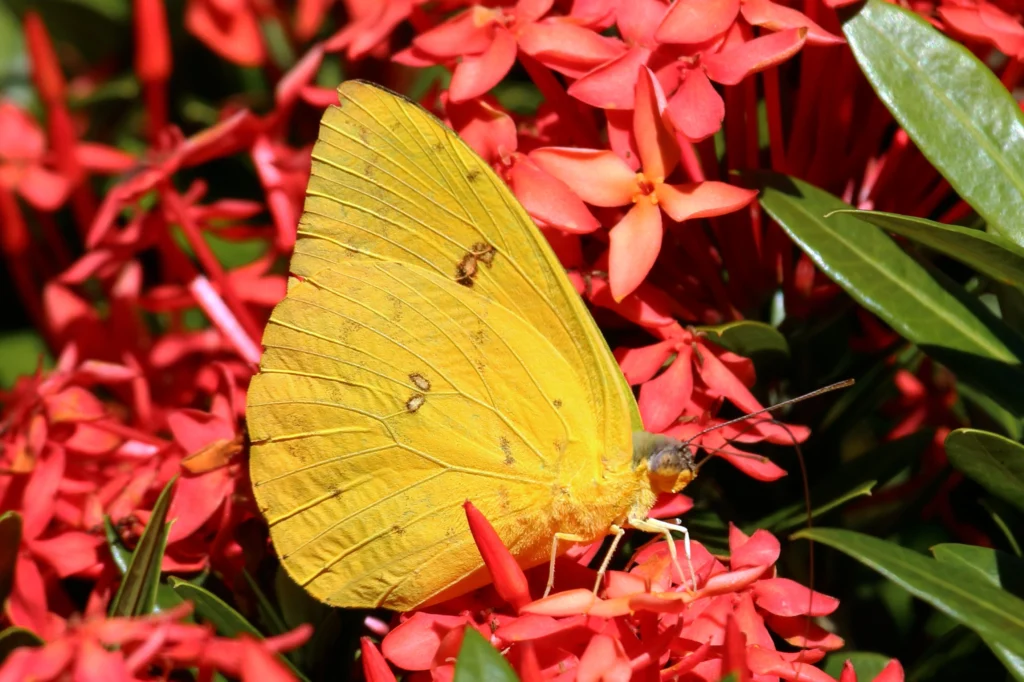“When a butterfly flutters its wings in one part of the world, it can eventually cause a hurricane in another.”
– Edward Lorenz
Known for its striking yellow color and wide distribution across the Americas, this butterfly plays a noteworthy role in many ecosystems and cultures. Its life cycle, migratory behavior, and symbolic meanings make it a subject of interest for both scientists and spiritual seekers alike.
Biological Overview
“The butterfly’s attractiveness derives not only from colors and symmetry: deeper motives contribute to it. We are reminded of summer, and of all things fair and fairer, because of its habits; because it flies about and alights on flowers, and is the type of air and sunshine, of vivacity and love.”
– John Burroughs
Taxonomy and Synonyms
Phoebis sennae is a member of the Pieridae family, which includes other well-known species like the Cabbage White and the Brimstone Butterfly. The Cloudless Sulphur has a few documented subspecies, which exhibit slight dissimilarities in color and size depending on their geographic location. Common synonyms include Eurema sennae and Colias sennae, reflecting its broad acknowledgement and study across different regions.
Physical Characteristics
One of the most distinctive features of the Cloudless Sulphur is its exciting yellow wings, which can span between 54 to 68 millimeters. The wings are spotless, giving the butterfly its “cloudless” signature. There are subtle gender differences: males typically have a brighter yellow shades, while females may have a greenish tint. These gender differences also extend to size, with females generally being slightly larger.
Distribution and Habitat
The Cloudless Sulphur is widely spread across North and South America. In North America, it is commonly found in the southern United States, including states like Texas, Florida, and Georgia. Its kind extends as far north as Canada during the summer months when it migrates. South America hosts a noteworthy population, with the butterfly thriving in habitats from the Pantanal in Brazil to the Caribbean islands like Jamaica and Cuba.
Preferred habitats include open spaces such as gardens, seashores, and watercourses, where the butterfly can easily find nectar sources and host plants for laying eggs.
Ecological Role
“A butterfly is like the soul of a person, it dries out in captivity.”
– Marisa Conde
Diet and Host Plants
The Cloudless Sulphur butterfly plays an important role in pollination. As an adult, it feeds primarily on nectar from many flowers, including those of the Senna plant, Partridge peas, and other nectar-rich species. This feeding behavior aids in the pollination of these plants, donating to the health and diversity of ecosystems.
The larvae, or caterpillars, have a more specialized diet, feeding solely on the leaves of the host plants, particularly species of the Senna genus. This selective feeding is crucial for the caterpillar’s growth and development, ensuring it has the nutrients.
Migration Patterns
One of the most remarkable features of the Cloudless Sulphur is its migratory behavior. In the United States, this butterfly is known for its fall migration, where large groups move southward to escape the colder northern climates. This migration can cover large distances, with the butterflies traveling from as far north as Canada to southern U.S. and even beyond Central America. The migration of the Cloudless Sulphur is not only a survival strategy but also an important ecological event, affecting the distribution of plants and other species along its route.
Interaction with Other Species
The Cloudless Sulphur butterfly shares its habitat with many other species, including other members of the Pieridae family, like the Yellow Angled-Sulphur (Anteos maerula) and the Statira Sulphur (Aphrissa statira). These species frequently compete for resources, such as nectar plants and host plants for egg-laying. The interactions between these species can sway their population number and the overall health of the ecosystem.
Cultural and Spiritual Significance
“Butterflies… flowers that fly and all but sing.”
– Robert Frost
Symbolism in Different Cultures
The Cloudless Sulphur butterfly and its significance:
- Native American Beliefs: In Native American cultures, butterflies are every so often seen as symbols of transformation and change. The Cloudless Sulphur, with its bright yellow wings, is mainly linked with the sun and light, symbolizing joy, hope, and new beginnings.
- South American and Asian Beliefs: In South American cultures, this butterfly is seen as a messenger from the spiritual world, guiding souls. In some Asian traditions, the butterfly is a symbol of revival and the recurring nature of life.
Spiritual Meaning and Symbolism
Beyond its cultural significance, the Cloudless Sulphur butterfly conveys profound spiritual meanings.
- Rebirth and Transformation: The butterfly’s life cycle, is a powerful symbol of rebirth and transformation. This process is often used to describe personal growth and spiritual awakening, where individuals undergo noteworthy changes in their lives, emerging stronger and more rational.
- Growth and Renewal: The metamorphosis of the Cloudless Sulphur reflects the concepts of growth and renewal. Just as the caterpillar must shed its old skin to become a butterfly, so for individuals too must let go of past limitations to embrace new opportunities and personal development.
- Hope, Happiness, and Positivity: The bright yellow wings of the Cloudless Sulphur are repeatedly linked with positivity. Seeing this butterfly is believed to bring happiness and hope to face the challenges of life and remain to optimistic.
Guidance and Trust in Personal Growth
The Cloudless Sulphur butterfly is also seen as a guide for those on a spiritual journey. Its presence is thought to offer reassurance and faith in the path one is following, encouraging self-discovery and growth. This butterfly teaches to embrace the unknown.
Conservation and Butterfly-Friendly Gardens
“Just when the caterpillar thought the world was over, it became a butterfly.”
– Chuang Tzu
Threats to the Cloudless Sulphur Butterfly
Despite its widespread distribution, the Cloudless Sulphur butterfly faces several threats that could impact its population. Habitat loss due to urbanization and agricultural extension is a significant concern, as it reduces the accessibility of host plants and nectar sources. Additionally, climate change poses a threat to the butterfly’s migratory patterns and its overall survival.
Creating Butterfly-Friendly Gardens
To support the conservation of the Cloudless Sulphur butterfly, creating butterfly-friendly gardens is an active strategy. Gardeners can play a key role by planting host plants like Senna and Partridge peas, which provide essential food sources for the caterpillars.
Butterfly-friendly gardens should also consider the butterfly’s habitat preferences, such as open spaces with sufficiently of sunlight. Avoiding the use of pesticides and providing shelter, such as shrubs and tall grasses, can create a safe environment for butterflies to thrive.
Interesting Facts
“Butterflies are nature’s angels. They remind us what a gift it is to be alive.”
– Robyn Nola
- The lifespan of a Cloudless Sulphur butterfly differs depending on environmental conditions, but adults typically live for about a month, with some living longer in favorable conditions.
- Unlike many other butterflies, the Cloudless Sulphur is time and again seen flying at high speeds and in straight lines, making it a challenge for photographers.
- The butterfly’s bright yellow color serves as a warning to predators, indicating that it may be toxic or distasteful, although the Cloudless Sulphur itself is not harmful.
Conclusion
“The butterfly is a flying rainbow.”
– Harriette Gillem Robinet
The Cloudless Sulphur butterfly is a remarkable species that captivates with its beauty, ecological importance, and cultural significance. From its role in pollination to its symbolic meanings in various cultures, this butterfly serves as a powerful reminder of the interconnectedness of life and the potential for transformation and growth. By understanding and appreciating the Cloudless Sulphur butterfly, we

